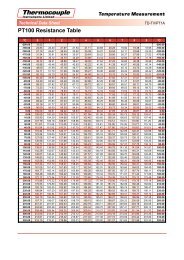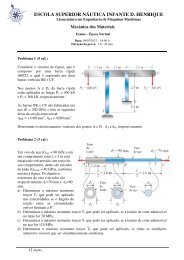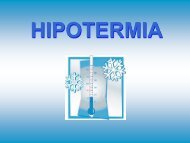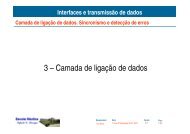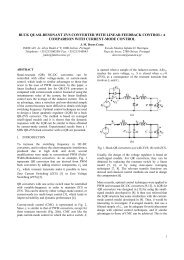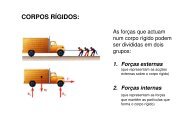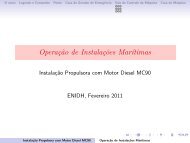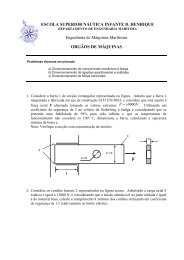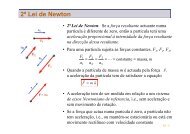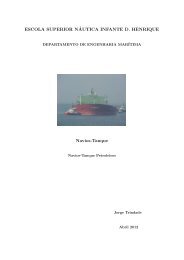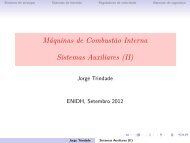Textos de Apoio (pdf)
Textos de Apoio (pdf)
Textos de Apoio (pdf)
You also want an ePaper? Increase the reach of your titles
YUMPU automatically turns print PDFs into web optimized ePapers that Google loves.
ITTC – Recommen<strong>de</strong>d<br />
Procedures<br />
Performance, Propulsion<br />
1978 ITTC Performance Prediction<br />
Method<br />
7.5 – 02<br />
03 – 01.4<br />
Page 6 of 31<br />
Effective Date<br />
1999<br />
Revision<br />
00<br />
for the <strong>de</strong>livered power.<br />
Trial prediction with ∆C FC - ∆w C corrections<br />
If CHOICE=1 the final trial predictions are<br />
calculated as follows:<br />
K<br />
J<br />
=<br />
S<br />
.<br />
C<br />
T<br />
TS<br />
2 2D<br />
2<br />
1<br />
+ ∆C<br />
( 1 − t)( − w + ∆w<br />
) 2<br />
With this K T /J² as input value, J TS and K QTS<br />
are read off from the full scale propeller characteristics<br />
and<br />
n<br />
P<br />
T<br />
DT<br />
( 1 − w + ∆w<br />
)<br />
TS<br />
FC<br />
TS C<br />
VS<br />
= (r/s)<br />
J . D<br />
= 2<br />
TS<br />
K<br />
5 3 QTS −3<br />
π . ρ.<br />
D . nT<br />
. .10 (kW)<br />
η<br />
RM<br />
Trial prediction with C NP correction<br />
If CHOICE = 2 the shaft rate of rotation is predicted<br />
on the basis of power i<strong>de</strong>ntity as follows.<br />
⎛ KQ<br />
⎞<br />
⎜<br />
J ³<br />
⎟<br />
⎝ ⎠<br />
T<br />
1000. C<br />
P<br />
. PDS<br />
=<br />
3<br />
2π<br />
. ρ.<br />
D²<br />
V ( 1 − w )³<br />
S<br />
TS<br />
C<br />
2.5 Analysis of Speed Trial Results<br />
The analysis of trials data is performed in a<br />
way consistent with performance prediction but<br />
starting P D and n backwards, i.e. from<br />
K<br />
Q<br />
PD<br />
=<br />
2π<br />
. ρ.<br />
D<br />
. n<br />
. η<br />
5 3 RM<br />
.10³<br />
J S is obtained from the full-scale open-water<br />
characteristics K Q ≈ J S then<br />
w<br />
= 1 − J<br />
. n.<br />
D<br />
T S<br />
/<br />
Further from K T ≈ J S characteristics<br />
T = K<br />
T<br />
. ρ.<br />
n²<br />
D<br />
( 1 − t)<br />
T.<br />
C T<br />
=<br />
1<br />
. ρ.<br />
V ². S<br />
2<br />
Then we obtain<br />
∆ C = C − C<br />
∆ w<br />
FC<br />
C<br />
= w<br />
2.6 Input Data<br />
T<br />
TS<br />
4<br />
− w<br />
Input data sheets are given in ENCL.1<br />
TS<br />
T<br />
V<br />
K<br />
Q0<br />
J ³<br />
⎛ K<br />
=<br />
⎜<br />
⎝ J<br />
Q<br />
⎞<br />
⎟<br />
⎠<br />
T<br />
.η<br />
RM<br />
( 1 − w )/<br />
J D<br />
nS = VS<br />
TS TS<br />
.<br />
n = C<br />
T<br />
NP<br />
n<br />
S<br />
2.7 Output Data<br />
- Output data I gives ITTC Standard Prediction<br />
with C P = C N = 1.0, together with<br />
mo<strong>de</strong>l and full scale propulsive coefficients<br />
(ENCL. 4).<br />
- Output data II gives the final ship prediction<br />
(ENCL. 5).


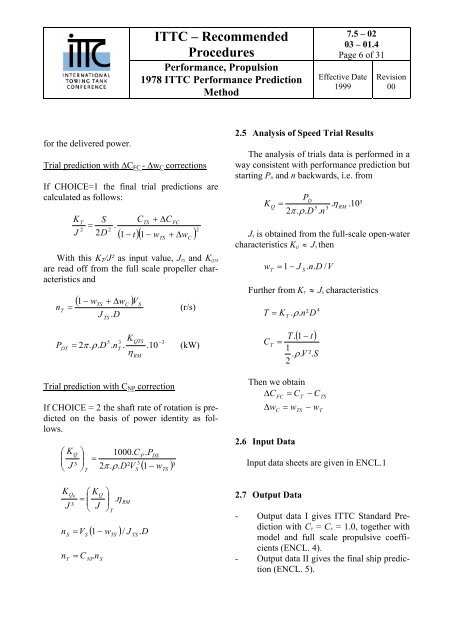
![Conceitos transmissao de dados .Sinais[.pdf]](https://img.yumpu.com/50982145/1/190x146/conceitos-transmissao-de-dados-sinaispdf.jpg?quality=85)
![Packages e interfaces[.pdf]](https://img.yumpu.com/50629553/1/190x134/packages-e-interfacespdf.jpg?quality=85)
